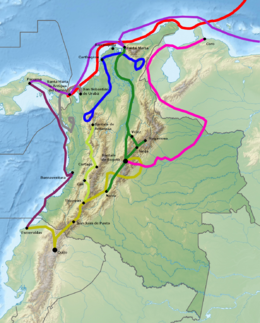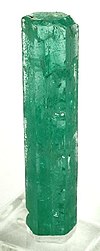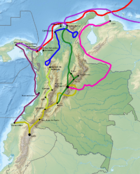Gonzalo Jiménez de Quesada
Gonzalo Jiménez de Quesada | |
|---|---|
 Oil portrait of Gonzalo Jiménez de Quesada at the hills of Suba (Palacio Liévano, Bogotá) | |
| Born | 1496[1] (or 1506 or 1509)[2] |
| Died | 16 February 1579 (aged ~70–85) Mariquita, New Kingdom of Granada |
| Nationality | Castilian |
| Other names | Gonzalo Jiménez de Quezada Gonzalo Ximénez de Quesada |
| Occupation | Conquistador, Explorer |
| Years active | 1536–1572 |
| Employer | Spanish Crown |
| Known for | Spanish conquest of the Muisca Spanish conquest of the Chibchan Nations Founder of Bogotá First mayor of Bogotá Quest for El Dorado |
Notable work | Memoria de los descubridores, que entraron conmigo a descubrir y conquistar el Reino de Granada (1576) |
| Parents |
|
| Relatives | Hernán Pérez de Quesada (brother) Francisco Jiménez de Quesada (brother) Melchor de Quesada (brother) Catalina Magdalena de Quesada (sister) Andrea Ximénez de Quesada (sister) Isabel de Quesada (half-sister) |
| Mayor of Bogotá | |
| In office 1538–1539 | |
| Preceded by | position established; zipa Sagipa) |
| Succeeded by | |
| Spanish colonization of the Americas |
|---|
 |
| History |
|
| People |
|
| Related |
|

Green is De Quesada's approximate trajectory
Note: route around the Sierra Nevada de Santa Marta incorrectly drawn

Gonzalo Jiménez de Quesada y Rivera, also spelled as Ximénez and De Quezada, (Spanish: [gonˈθalo xiˈmeneθ ðe keˈsaða];1496[1] – other sources state 1506 or 1509[2][3] – Mariquita, New Kingdom of Granada 16 February 1579) was a Spanish explorer and conquistador in northern South America, territories currently known as Colombia. He explored the northern part of South America. As a well-educated lawyer he was one of the intellectuals of the Spanish conquest. He was an effective organizer and leader, designed the first legislation for the government of the area, and was its historian. After 1569 he undertook explorations toward the east, searching for the elusive El Dorado, but returned to New Granada in 1573. He has been suggested as a possible model for Cervantes' Don Quixote.[4]
Family[]
His father, Luis Jiménez de Quesada,[5] was a hidalgo relative of Gonzalo Francisco de Cordoba, and he had two well-known distant cousins, the conquistadores of Mexico and Peru respectively: Hernán Cortés and Francisco Pizarro. He had three younger brothers; Hernán and Francisco, who also were conquistadors, and Melchor, and a sister, Andrea.[6]
Conquest of the Muisca Confederation[]
De Quesada was an Andalusian lawyer, trained in Granada.[7] He was appointed chief magistrate in 1535 and second in command for an expedition to present-day Colombia, because in that period he was not in good standing with the people at home because he had just lost an important court case in which his mother's family was economically involved.[8] The commander of the expedition, Pedro Fernández de Lugo (governor of the Canary Islands), had bought the governorship of Colombia and had equipped a fleet and assembled over a thousand men. And so they set sail to Colombia, thinking they would find a very rich land, full of gold and pearls. But when, after two month of navigation, they reached the small coastal settlement of Santa Marta, all they found was a conglomeration of hovels and filthy, disease-ridden colonists who went about dressed in skins or roughly woven and padded cotton clothes made by the natives from surrounding areas. Soon food became scarce and tropical fevers began to smite down the strongest.
In 1536, De Quesada (who had no military experience) was chosen by De Lugo to command an expedition to explore into the interior of New Granada, hoping to discover the dreamed El Dorado. A land party under De Quesada, with Hernán Pérez de Quesada (his brother), Juan San Martín, Juan del Junco (as second in command) Lázaro Fonte and Sergio Bustillo, struck south from Santa Marta, crossed the Cesar River, and arrived at Tamalameque on the Magdalena River. A support fleet of 6 (or 5) ships had also sailed from Santa Marta with 900 men to navigate the Magdalena.[7] Only two of the vessels actually arrived at Tamalameque, and subsequently returned to Santa Marta with many of De Quesada's men. Continuing up the Magdalena as far as La Tora (Barrancabermeja), De Quesada and his men ascended the Opon River into the cordillera, reaching the Opon hills, Chipata (near Vélez) (March 1537) and the valley of the Suárez River. Passing Lake Fúquene and Lake Suesca, they reached Nemocón and Zipaquirá and finally entered the Muisca Confederation (ruled from Bacatá, present day Funza and Hunza, today known as Tunja).
Only 179 men out of 800 survived, suffering terribly in the jungle: they were forced to eat snakes, lizards, frogs, and even the leather torn from their harnesses and the scabbards of their swords. In Bogotá, Quesada resigned and called for an election; he was elected captain-general, and threw off the last link that held him to the governor. The Muisca had two rulers. The psihipqua Bogotá, ruled in Muyquytá; the other, the hoa Eucaneme, ruled in Hunza. Taking advantage of a war between the two chiefdoms, Quesada's force subdued Muyquytá and then successfully attacked Hunza. At this point it was time to establish a settlement so that the earth itself might properly belong to De Quesada and his men. They chose a spot next to the towering peaks of the east, where the land was high and the rains would quickly run off, where the mountains would protect them from attackers and the jungles below. Quesada placed his right foot on the bare earth and said simply, "I take possession of this land in the name of the most sovereign emperor, Charles V." The settlement was at first called New City of Granada, but later they changed it to Santa Fé de Bogotá, now known simply as Bogotá, from the Chibcha word Bacatá, the name of one of the two main cacicazgos of the Muisca Confederation.
Quesada remained in the region until the arrival of two expeditions at the end of 1538: Sebastián de Belalcázar from Quito, Ecuador, one of the captains of Pizarro who had mutinied against his leader; and Nikolaus Federmann, a German from Venezuela who had rebelled against another German named Hohermuth. The three captains met on the savanna of New Granada. All three wanted to claim New Granada for themselves. In order to resolve their dispute, De Quesada persuaded them to go back to Spain with him and to submit their rival territorial claims to the arbitration of the crown. In July 1539, they sailed for Spain from Cartagena. However, none of them obtained the governorship. De Quesada, after nearly a dozen years of wandering disconsolately through the gaming halls of Europe, returned to New Granada in 1550. Here, he settled down to live for nearly twenty years. He was a respected colonist, becoming the most influential man in the colony. He protected his fellow colonists from the severity of the officials and restrained the encomenderos (large landholders) greed. But his own desire for wealth and gold continued to live inside him.
Later expeditions[]
In 1569, at the age of 63, De Quesada received a commission to conquer the Llanos to the east of the Colombian cordillera. From Bogotá in April 1569 with 500 mounted soldiers, 1500 natives, 1100 horses and pack animals, 600 head of cattle, 800 pigs, a large number of negro slaves and 8 priests, he first descended to Mesetas on the upper Guejar River. There most of the livestock was destroyed by a grass fire. De Quesada's expedition then moved to nearby San Juan de los Llanos, where a course was set for east-southeast (by the guide Pedro Soleto), and maintained for the following two years. After a year or so some men returned with Juan Maldonado, reaching San Juan after six months with few survivors. De Quesada eventually reached (San Fernando de) Atabapo at the confluence of the Guaviare and the Orinoco (in December 1571), any further movement requiring the construction of ships. He therefore dejectedly returned to Bogotá, arriving in December 1572 with only 25 Spaniards, 4 natives, 18 horses and 2 priests. The expedition had been one of the most expensive disasters on record. After a brief period of service in a frontier command (during which he suppressed an indigenous uprising) De Quesada, afflicted with leprosy, overcome with despair at his debts, owing more than 60 thousand ducats, was forced to seek a milder climate and died quietly, aged 70 to 85, in Mariquita, an important market town in the New Kingdom of Granada.
Death and legacy[]
After his death in, Mariquita where he was buried in the Santa Lucía Abbey. His remains were there until 1597 when they were exhumed and transferred to Bogotá, the city founded by him.
Named after Jiménez de Quesada[]
- , important avenue in central Bogotá
- Avenida Jiménez (TransMilenio), TransMilenio station serving this avenue
- Torres Gonzalo Jiménez de Quesada, five towers with residences in Bogotá
Gallery[]

Jiménez de Quesada

Statue

Coat of arms
See also[]
- List of conquistadors in Colombia
- Hernán Pérez de Quesada, Juan de Céspedes
- New Kingdom of Granada, Paolo Giovio
References[]
- ^ Jump up to: a b (in Spanish) Antijovio
- ^ Jump up to: a b Graham (1922) p. 2
- ^ There is considerable disagreement about Gonzalo Jimenez de Quesada's birth year and place.[citation needed]
- ^ E. C. Riley (March 1966), "Who's Who in Don Quixote? Or an Approach to the Problem of Identity" MLN 81(2) (Spanish Issue), 113–30
- ^ (in Spanish) Fundaciones antecedentes a la conquista de la aldea Chicamocha
- ^ (in Spanish) Biography Gonzalo Jiménez de Quesada – Banco de la República
- ^ Jump up to: a b "Jiménez de Quesada, Gonzalo." (2008). Encyclopædia Britannica Online School Edition. 20 October 2008.
- ^ John A. Crow, The Epic of Latin America, 116–26
Bibliography[]
- Cunningham Graham, R. B.. 1922. The Conquest of New Granada, Being the Life of Gonzalo Jimenez de Quesada. W. Heinemann.
Works by Jiménez de Quesada[]
- Jiménez de Quesada, Gonzalo. 1576. Memoria de los descubridores, que entraron conmigo a descubrir y conquistar el Reino de Granada. Accessed 8 July 2016.
Further reading[]
In Spanish
- De Castellanos, Juan. 1857 (1589). Elegías de varones ilustres de Indias, 1–567. Accessed 8 July 2016.
- Fernández de Piedrahita, Lucas. 1688. Historia general de las conquistas del Nuevo Reino de Granada. Accessed 8 July 2016.
- Friede, Juan. 1960. Gonzalo Jiménez de Quesada a través de documentos históricos. Academia Colombiana de Historia.
- Friede, Juan. 1979. El adelantado don Gonzalo Jiménez de Quesada (2 vols.). Carlos Valencia editores.
- Jiménez de Quesada, Gonzalo. 1952 (1567). El Antijovio (with introduction by Manuel Ballesteros Gaibrois). Instituto Caro y Cuervo.
- Rodríguez Freyle, Juan, and Darío Achury Valenzuela. 1979 (1859) (1638). El Carnero – Conquista i descubrimiento del nuevo reino de Granada de las Indias Occidentales del mar oceano, i fundacion de la ciudad de Santa Fe de Bogota, 1–598. Fundacion Biblioteca Ayacuch. Accessed 21 November 2016.
- Simón, Pedro. 1892 (1626). Noticias historiales de las conquistas de Tierra Firme en las Indias occidentales (1882–92) vol.1–5. Accessed 8 July 2016.
In English
- Arciniegas, Germán. 1942. The Knight of El Dorado: The Tale of Don Gonzalo Jiménez de Quesada and His Conquest of New Granada, Now Called Colombia. The Viking Press.
- Avellaneda Navas, José Ignacio. 1995. The Conquerors of the New Kingdom of Granada. University of New Mexico Press.
- Crow, John A.. 1992 (1946). The Epic of Latin America (4th ed.), 116-126. University of California Press.
- Francis, J. Michael. 2007. Invading Colombia: Spanish Accounts of the Gonzalo Jiménez de Quesada Expedition of Conquest. University Park: Penn State Press.
External links[]
| Wikimedia Commons has media related to Gonzalo Jiménez de Quesada. |
- (in Spanish) Personajes de la Conquista a América - Banco de la República
- (in Spanish) List of conquistadors of the expedition led by Gonzalo Jiménez de Quesada – Banco de la República
- (in Spanish) Conquista rápida y saqueo cuantioso de Gonzalo Jiménez de Quesada
- 1579 deaths
- 16th-century Spanish people
- 16th-century explorers
- Andalusian conquistadors
- Spanish conquistadors
- City founders
- Explorers of Amazonia
- Muisca scholars
- History of the Muisca
- Colonial Colombia
- Mayors of Bogotá
- University of Salamanca alumni
- Don Quixote
- Miguel de Cervantes
- Spanish Roman Catholics
- 16th-century Roman Catholics
- Burials at the Primatial Cathedral of Bogotá




